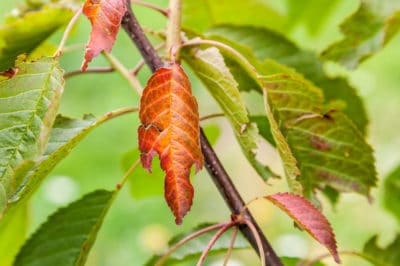Identifying Common Cherry Tree Diseases
Cherry tree diseases are caused by bacteria and viruses which attack the tree’s roots, leaves, branches, or fruit. The most common of these problems are:
- Armillaria Root Rot (Armillaria mellea)
The first indication of this fungal disease is often noticed on the leaves which wilt and become yellow and dull looking. The source of the problem, however, is a long-lived fungus growing within the root system. Look for white or yellow, flat fungus growing in the bark. Sometimes, this fungus can be stopped from killing the tree by digging a hole around the base of the trunk and exposing and drying out the fungus. - Brown Rot (Monilinia fructicola)
This is another fungal disease common to cherry trees and other stone fruit. Warm, wet, spring weather allows the fungus to grow and spread, infecting blossoms and fruit, but not killing the tree. Look for flowers which turn brown, but do not fall from the tree and depressed spots on twigs and blooms with a sticky sap oozing from them. In addition, mold appears on flowers and small branches, and the disease moves on to affect the fruit. Control brown rot by starting with a tree resistant to this disease, by planting it in well-drained soil, and by pruning branches and thinning the fruit crop each year. - X–disease Also known as cherry buckskin disease, this cherry tree disease is spread by a parasitic organism transmitted by leafhoppers. Leaves curl and become yellow and purple or reddish spots appear on the leaves followed by holes developing in foliage. Leaves and fruit drop from the tree, and fruit has a leathery, bumpy appearance and fails to ripen properly. Control X-disease by removing the alternative host plant, chokeberries, from the area, keeping weeds down, and by not watering or fertilizing too much.
- Powdery Mildew (Podosphaera species)
This is another fungal disease which appears in wet, warm weather. A white or grey powdery mildew appears on flower buds, leaves, small branches, and leaves may curl and become crinkled. Proper irrigation, removal of water sprouts, and application of sulfur sprays can control this problem.
Preventing Cherry Tree Diseases
Proper care of cherry trees from planting throughout life is the best way of preventing diseases. Selecting a cherry variety best suited for your USDA climate zone also helps reduce the possibility of disease problems.
Text:
Artikelbild:
